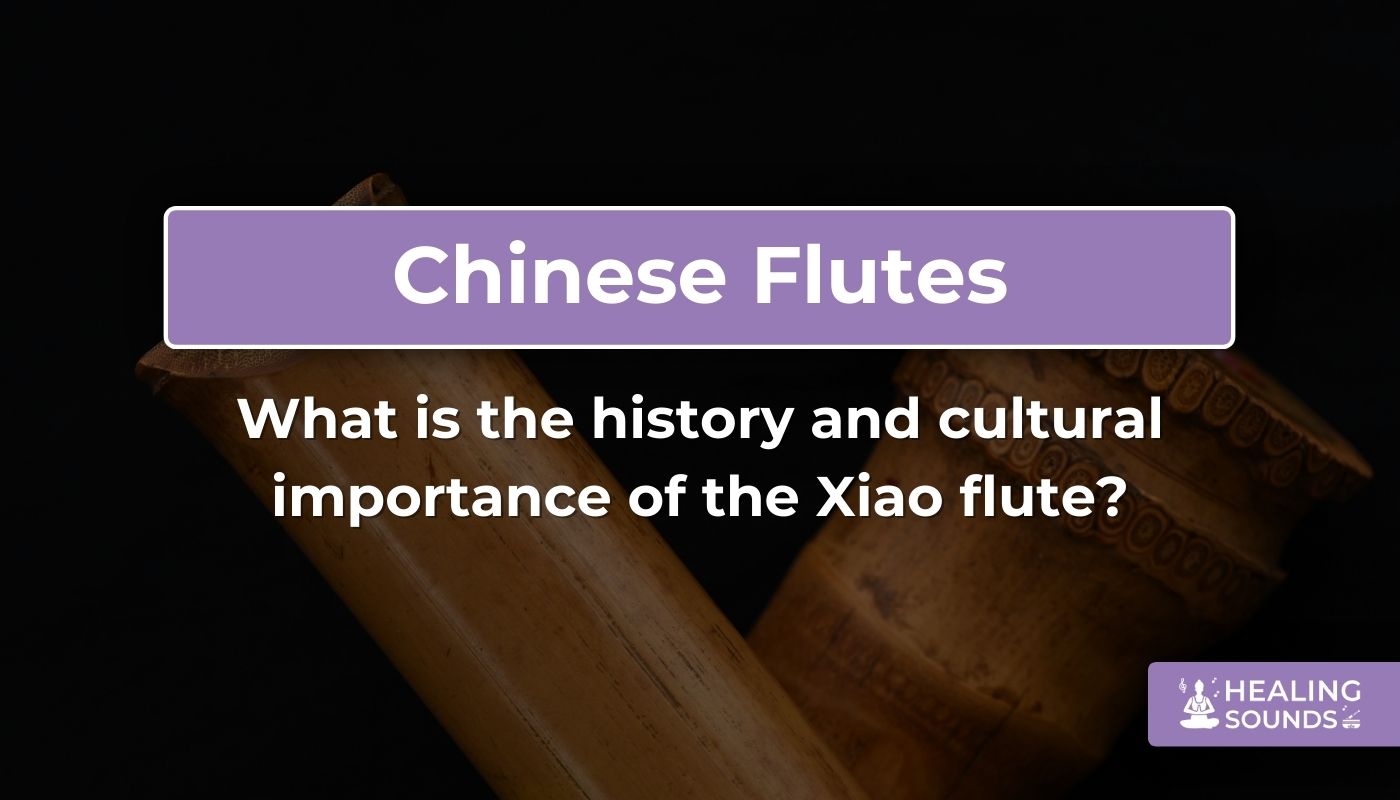Die Xiao-Flöte zählt zu den ältesten und kulturell bedeutendsten Blasinstrumenten Chinas und blickt auf eine jahrtausendealte Geschichte zurück. Wir erkunden die faszinierende Reise dieser traditionellen chinesischen Flöte und entdecken nicht nur ihre Entwicklung durch die verschiedenen Dynastien, sondern auch ihre tiefe kulturelle Symbolik und ihre anhaltende Anziehungskraft. Das Xiao-Instrument hat die chinesische Musik, Meditationspraktiken und spirituelle Zeremonien nachhaltig geprägt und ist damit mehr als nur ein Musikinstrument, sondern auch ein Träger des kulturellen Erbes. Wenn Sie sich für die traditionelle chinesische Kultur, einzigartige Musikinstrumente oder die beruhigenden Klänge im Wellnessbereich interessieren, entdecken Sie mit uns die reiche Geschichte der Xiao und ihre Bedeutung für die Gegenwart.
Die alten Wurzeln freilegen: Geschichte der Xiao-Flöte
Die Geschichte der Xiao-Flöte beginnt tief in Chinas Vergangenheit. Wer ihre Ursprünge kennt, kann ihren nachhaltigen kulturellen Einfluss besser einschätzen.
Ursprünge in der Antike
Archäologische Funde deuten darauf hin, dass Vorläufer der Xiao-Flöte bereits vor über 2.500 Jahren existierten, möglicherweise sogar noch früher. Diese frühen Versionen waren oft einfache Langlochflöten aus Materialien wie Knochen oder Bambus, die häufig mit alten Hofritualen und Volkstraditionen in Verbindung gebracht wurden. Der Begriff „Xiao“ selbst hat antike Wurzeln und bezeichnet in frühen Texten im Allgemeinen Langlochflöten.
Entwicklung während der Han-Dynastie
Während der Han-Dynastie (206 v. Chr. – 220 n. Chr.) begann sich die Bambusflöte , die wir heute als Xiao kennen, zu standardisieren und an Bedeutung zu gewinnen. Bambus wurde aufgrund seiner natürlichen Resonanz, seines geringen Gewichts und seiner großen Verbreitung zum bevorzugten Material. In dieser Ära wurde die Xiao stärker in höfische Musikensembles und Solo-Auftrittstraditionen integriert.

8-Loch G-Tonart Handgefertigte Xiao-Flöte aus Bambus
$59.99 $89.99
Dieses G Key Xiao ist aus hochwertigem Bambus gefertigt, der sein altes Erbe widerspiegelt, und bietet ruhige, sanfte Töne, die perfekt sind, um seinen historischen Klang und seine beruhigenden Eigenschaften zu erleben.
Entdecken Sie G Key Bamboo XiaoDie Entwicklung der Xiao in der chinesischen Musik
Die Xiao-Flöte war nicht statisch; sie entwickelte sich zusammen mit dem chinesischen Musikgeschmack und den Aufführungspraktiken weiter und festigte ihren Platz in der Klanglandschaft des Landes.
Blütezeit in der Tang-Dynastie
Die Tang-Dynastie (618–907 n. Chr.) gilt als goldenes Zeitalter der chinesischen Musik und Kunst. In dieser Zeit erlebte die Xiao-Flöte ihre Blütezeit und wurde zu einem festen Instrument in Hoforchestern (Yayue) und Unterhaltungsensembles (Suyue). Ihre Ausdrucksmöglichkeiten wurden zunehmend von Komponisten und Interpreten erkannt und genutzt.
Xiao vs. Dizi: Eine Geschichte von zwei Flöten
Die Xiao wird oft im Zusammenhang mit der Dizi erwähnt, einer anderen ikonischen chinesischen Flöte . Obwohl beide wichtig sind, unterscheiden sie sich erheblich. Die Dizi ist eine Querflöte (seitlich geblasen), typischerweise mit einer Membran (Dimo), die ein zusätzliches Loch bedeckt und ihr einen helleren, summenden Klang verleiht. Im Gegensatz dazu wird die Xiao längs geblasen (vertikal gespielt) und hat keine Membran, was zu einem weicheren, sanfteren und hauchigeren Ton führt, der oft als sanft oder melancholisch beschrieben wird.
Diese vertikale Spielhaltung des Xiao-Instruments ermöglicht eine nuancierte Atemkontrolle und fördert ein Gefühl der Intimität zwischen dem Spieler und dem Instrument, was zu seinem tiefen Ausdruckspotenzial beiträgt.
Die Seele des Xiao: Kulturelle Bedeutung und Symbolik
Über ihre musikalischen Anwendungen hinaus hat die Xiao-Flöte in China eine tiefgreifende kulturelle Bedeutung . Ihr Klang ist eng mit philosophischen und spirituellen Konzepten verwoben.
In der chinesischen Tradition symbolisiert die Xiao-Flöte oft Ruhe, Einsamkeit, Anmut und Selbstbeobachtung. Ihre sanften, ätherischen Töne sollen ein Gefühl von Frieden und Kontemplation hervorrufen, was sie im Laufe der Geschichte zu einem beliebten Instrument bei Gelehrten, Dichtern und Mönchen machte.
Verbindung zum Taoismus und zur Meditation
Der Klang des Xiao erinnert stark an taoistische Prinzipien und betont Harmonie mit der Natur, Einfachheit und inneren Frieden. Seine eindringlichen Melodien werden oft in taoistischen Zeremonien und Meditationspraktiken verwendet, um den Geist zu beruhigen und spirituelle Verbindungen zu fördern. Praktizierende der Klangheilung und Meditation schätzen die erdenden Frequenzen des Xiao , da sie Entspannung und Achtsamkeit fördern.
- Ruhe: Seine sanften Töne vermitteln Ruhe und Frieden.
- Selbstbeobachtung: Der Klang regt zur stillen Reflexion an.
- Eleganz: Wird mit Gelehrten, Dichtern und kultivierten Künsten in Verbindung gebracht.
- Verbindung zur Natur: Wird oft in natürlichen Umgebungen gespielt, verbunden mit dem organischen Ursprung von Bambus.
Die Xiao-Flöte in der modernen Welt
Trotz ihrer antiken Ursprünge ist die Xiao-Flöte auch heute noch relevant und findet weltweit ein neues Publikum und neue Anwendungsmöglichkeiten.
Dank der Globalisierung und des wachsenden Interesses an Weltmusik hat der einzigartige Klang der Xiao-Flöte Zuhörer weit über China hinaus in seinen Bann gezogen. Er ist nicht nur in traditionellen chinesischen Musikensembles zu hören, sondern auch in zeitgenössischen klassischen Kompositionen, Filmmusiken (die bestimmte Stimmungen oder kulturelle Kontexte hervorrufen), New-Age-Musik und Ambient-Soundscapes.
Rolle im Wellness- und Klangheilungsbereich
Die beruhigenden Eigenschaften der Xiao-Flöte machen sie zu einem wertvollen Instrument moderner Wellness-Praktiken. Ihre wohltuenden Frequenzen werden in Klangbädern, Meditationssitzungen und therapeutischen Situationen eingesetzt, um Stress abzubauen, Entspannung zu fördern und das emotionale Wohlbefinden zu steigern. Das Spielen selbst fördert eine tiefe, kontrollierte Atmung, ähnlich wie bei meditativen Übungen.
Entdecken Sie unsere vielfältige Xiao-Flötensammlung

39,99 €
59,99 €
Entdecken Sie die Klangvielfalt dieser handgefertigten Bambusflöte in mehreren Tonarten, die traditionelle Handwerkskunst verkörpert. Mehr erfahren ➔

69,99 €
99,99 €
Erleben Sie mit dieser robusten Silberflöte eine moderne Interpretation des Xiao-Instruments . Sie bietet klare Töne, die zu verschiedenen Musikstilen passen. Mehr erfahren ➔

69,99 €
99,99 €
Diese professionelle chinesische Bambusflöte mit 6 Löchern bietet satte, weiche Töne, ideal für traditionelle Darbietungen und Entspannung. Mehr erfahren ➔
Xiao spielen: Vorteile für Körper und Geist
Die Beschäftigung mit der Xiao-Flöte bietet mehr als nur musikalischen Ausdruck; sie bietet spürbare Vorteile für das geistige und körperliche Wohlbefinden.
Die kontrollierte, tiefe Atmung, die zum Spielen des Xiao erforderlich ist, stärkt die Atemmuskulatur und verbessert mit der Zeit die Lungenkapazität. Darüber hinaus fördert die Konzentration, die für die Erzeugung klarer Töne und Melodien erforderlich ist, die Achtsamkeit, hilft, den Geist zu zentrieren und geistige Unordnung zu reduzieren.
- Verbesserte Atemkontrolle: Entwickelt Zwerchfellatmung und Lungenkraft.
- Stressabbau: Die beruhigenden Klänge und das konzentrierte Spielen fördern die Entspannung.
- Achtsamkeitsübung: Erfordert Präsenz und Konzentration, um ablenkende Gedanken zu beruhigen.
- Emotionaler Ausdruck: Bietet ein nonverbales Ventil für Gefühle und Kreativität.
- Kulturelle Verbindung: Bietet eine greifbare Verbindung zu alten chinesischen Kunsttraditionen.
Für alle, die Ausgleich und ein kreatives Ventil mit positiven Auswirkungen auf das Wohlbefinden suchen, kann das Erlernen der Xiao-Flöte eine äußerst lohnende Reise sein. Erfahren Sie mehr über die weite Welt der chinesischen Musikgeschichte, um den Kontext voll und ganz zu verstehen.
Abschluss
Die Xiao-Flöte ist ein bemerkenswertes Instrument, dessen vielfältige Einflüsse sich durch Jahrhunderte chinesischer Geschichte und Kultur ziehen. Von alten Ritualen und kaiserlichen Höfen bis hin zu modernen Konzertsälen und Wellness-Studios erklingt ihr sanfter, beschwörender Klang bis heute. Ihre anhaltende kulturelle Bedeutung liegt in ihrer Fähigkeit, Ruhe, Introspektion und eine tiefe Verbundenheit mit künstlerischen und spirituellen Traditionen zu vermitteln.
Ob Sie als Musiker neue Klänge entdecken, von der chinesischen Kultur fasziniert sind oder nach Instrumenten für Achtsamkeit und Entspannung suchen – die Xiao-Flöte bietet ein einzigartiges und tiefgreifendes Erlebnis. Bei Healing Sounds sind wir stolz darauf, authentische, hochwertige Xiao-Flöten anzubieten, die es Ihnen ermöglichen, dieses uralte Erbe zu erleben und seine beruhigenden Melodien zu entdecken. Entdecken Sie unsere kuratierte Sammlung und beginnen Sie Ihre eigene Reise mit dem zeitlosen Klang der Xiao.
Häufig gestellte Fragen zur Xiao-Flöte
Die Xiao-Flöte hat in China eine mindestens 2.500-jährige Geschichte. Frühe Formen existierten bereits in der Antike, doch während der Han-Dynastie (206 v. Chr. – 220 n. Chr.) wurde sie standardisierter und bekannter und wurde hauptsächlich aus Bambus gefertigt. Während der Tang-Dynastie (618–907 n. Chr.) erlebte sie in der Hofmusik und in Solotraditionen eine weitere Blütezeit.
Weltweit haben Flöten oft eine tiefe kulturelle Bedeutung und repräsentieren Aspekte wie Natur (Vogelgesang-Imitation), Spiritualität (Verwendung in Ritualen), Gemeinschaft (Volksmusik) oder bestimmte Gefühlszustände (Freude, Trauer). Die spezifische Bedeutung variiert stark je nach Kultur und Flötentyp.
Chinesische Flöten wie die Xiao und die Dizi haben eine bedeutende kulturelle Bedeutung. Sie sind ein wesentlicher Bestandteil der traditionellen chinesischen Musik (Hof-, Volks- und Opernmusik), symbolisieren philosophische Konzepte (wie die Verbindung der Xiao zu Ruhe und Taoismus) und werden in Ritualen und Meditationspraktiken verwendet. Sie stellen einen zentralen Teil des chinesischen musikalischen Erbes dar.
Die Flöte ist eines der ältesten bekannten Musikinstrumente. Archäologische Funde deuten auf Flöten aus Tierknochen hin, die in Europa über 40.000 Jahre alt sind (wie die Divje-Babe-Flöte). Flöten entwickelten sich unabhängig voneinander in vielen Kulturen weltweit. Ursprünglich wurden sie aus natürlichen Materialien wie Knochen, Holz, Schilf und Bambus gefertigt und spielten seit der Vorgeschichte eine wichtige Rolle in Ritualen, der Kommunikation und der Unterhaltung.

